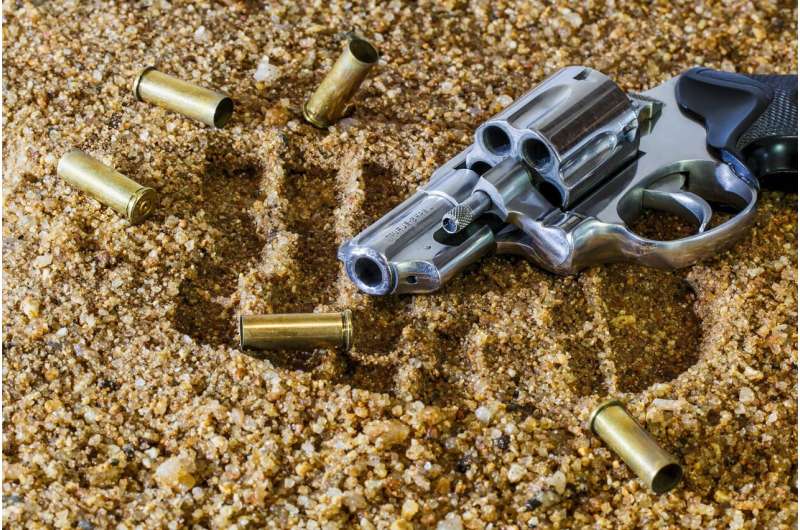This article has been reviewed according to Science X's editorial process and policies. Editors have highlighted the following attributes while ensuring the content's credibility:
fact-checked
peer-reviewed publication
trusted source
proofread
Half of people from Chicago witness a shooting by age 40, study suggests

A study tracking the lives of Chicagoans from childhood and adolescence in the 1990s to the start of middle age has found that 56% of Black and Hispanic residents from across the city witnessed at least one shooting by the time they turned 40.
White residents were exposed to gun violence at less than half the rate of Black and Hispanic residents, although it was still high: 25% of white Chicagoans had witnessed a shooting before turning 40.
Across all racial categories, 50% of the study's participants had been exposed to gun violence by age 40. The average age to witness a shooting was just 14 years old.
Of those in the study, more than 7% of Black and Hispanic people had themselves been shot before turning 40, compared to 3% of white people. The average age for being shot was 17 years old.
Researchers also compared the locations of gun violence incidents in the year leading up to recent study interviews in 2021. Rates of shootings within a 250-meter radius of the homes of Black participants were more than 12 times higher than those of white participants. Rates of shootings near the homes of Hispanic people were almost four times higher than for white people.
The research team continued to gather data for participants who had moved out of the city, although the vast majority of gun violence took place within Chicago.
The sustained stress of living with the potential for gun violence likely takes a "cumulative physiological toll" on Chicago's citizens—and people in cities across the U.S., argue researchers.
Findings from the latest study, led by a University of Cambridge criminologist in collaboration with researchers from Harvard and Oxford universities, are published today in JAMA Network Open, a journal of the American Medical Association
"Existing evidence suggests that the long-term stress of exposure to firearm violence can contribute to everything from lower test scores for schoolkids to diminished life expectancy through heart disease," said study lead author Dr. Charles Lanfear, from the University of Cambridge's Institute of Criminology.
"We expected levels of exposure to gun violence to be high, but not this high. Our findings are frankly startling and disturbing," said Lanfear. "A substantial portion of Chicago's population could be living with trauma as a result of witnessing shootings and homicides, often at a very young age."
"It is clear that Black people in particular are often living in a very different social context, with far higher risks of seeing and becoming victims of gun violence in the streets near their homes lasting into middle age."
The Project on Human Development in Chicago Neighborhoods (PHDCN), a Harvard University study, has followed thousands of children since they were first surveyed in the 1990s, gathering life experiences as they grow up in the city or move away. Participants are from households selected at random from a set list of 80 Chicago districts—carefully chosen to reflect Chicago's spectrum of race and levels of social advantage, or lack thereof.
The latest research focused on data gathered from 2,418 of participants born in the early 1980s through to the mid-1990s, equally split between men and women.
The oldest study participants, born in 1981, hit adolescence in the early-to-mid 1990s when lethal violence reached a peak in the U.S. "The nineties saw a demographic bump collide with high poverty levels and rises in gang crime resulting in part from the crack epidemic," said Lanfear.
"However, since 2016 we have seen another surge in gun violence. Rates of fatal shootings in Chicago are now higher than they ever were in the nineties."
Men are far more likely to be involved in violent crime, and this is reflected in the risks of actually being shot by age 40, which are five times higher for men than women. However, there was a much smaller difference between the sexes for exposure to gun violence: 43% of women and 58% of men had seen someone shot.
"The chronic stress effects on women from being so highly exposed to firearm violence may well be substantial in Chicago, and indeed in many U.S. cities," said Lanfear.
"The study participants are taken from right across Chicago, and only a tiny fraction will be involved in any kind of crime. Given the levels of women and children witnessing gun violence in the city, the vast majority of this exposure will be as bystanders in public spaces, in streets or outside schools."
"The public health consequences of life in violent and traumatized neighborhoods will be playing out not just in Chicago, but in many cities right across the United States," Lanfear said.
More information: Inequalities in Exposure to Firearm Violence by Race, Sex, and Birth Cohort From Childhood to Age 40 Years, 1995-2021, JAMA Network Open (2023). DOI: 10.1001/jamanetworkopen.2023.12465



















